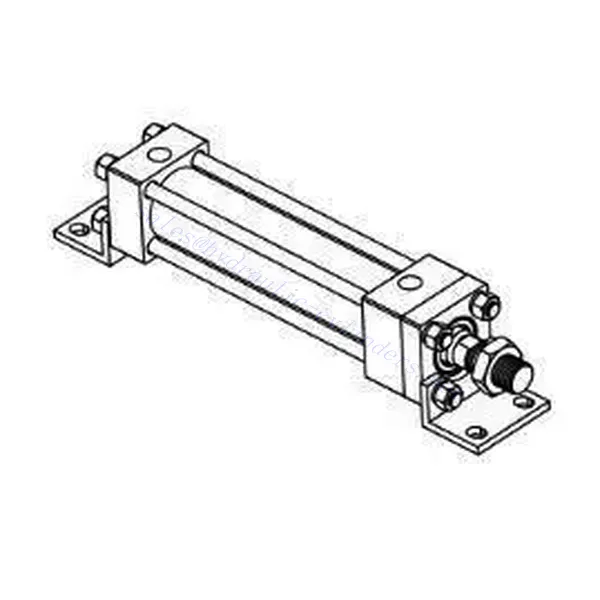LB 前后脚踏式重型杆液压缸
LB 前后脚踏式重型杆液压缸
LB front and rear foot heavy rod hydraulic cylinders are state-of-the-art hydraulic elements designed to meet the needs of various industrial applications. With its rugged construction, superior force output, and unique front and rear foot design, this hydraulic cylinder offers exceptional power, precision, and versatility. Whether heavy lifting, pushing, or pulling, LB front and back foot heavy rod hydraulic cylinders provide reliable performance to optimize industrial operations.
重型杆式液压缸的基本特征:
坚固的结构 This heavy rod hydraulic cylinder is made of high-quality materials such as solid steel or alloys to ensure durability and longevity. Its rugged construction allows it to handle heavy loads, high pressures, and challenging environmental conditions, making it suitable for demanding industrial tasks.
High Force Output: LB front and rear foot heavy rod hydraulic cylinders have an impressive force output, making them ideal for applications that require a lot of power. Its large piston diameter and high-pressure capability provide exceptional strength to handle heavy-duty tasks easily.
Front and Back Foot Design: This hydraulic cylinder has a unique show and rear foot design for various mounting options. The front and back foot arrangement provides stability and increases the bearing capacity of the cylinder. This design is easy to install and integrate into various hydraulic systems and equipment configurations, providing flexibility and adaptability.
Precise Control: LB front and rear foot heavy rod hydraulic cylinders use precision machined components and high-quality seals to ensure accurate and reliable operation. It can precisely control the movement and positioning of loads for efficient and appropriate processing.

LB Front And Back Foot Type Heavy Rod Hydraulic Cylinder Parameter:

LB 前后脚踏式重型杆液压缸 Usage Method:
安装: First, safely install the LB front and rear foot heavy rod hydraulic cylinders using appropriate brackets or fixtures. Ensure proper alignment and stability during installation to prevent cylinder misalignment or stress.
液压系统集成: Follow the manufacturer’s instructions and guidelines to connect hydraulic lines to cylinder ports. The cylinder is integrated into the hydraulic system by clicking it to a suitable pump or power unit. Ensure cylinder specifications and operating requirements are met.
控制和操作: The control valve in the hydraulic system regulates the flow of hydraulic oil into and out of the cylinder. Adjust the control Settings according to the desired linear motion and force output. Test the movement of the cylinder to verify its function and responsiveness.
LB 前后脚踏式重型杆液压缸 Maintenance:
Regular maintenance ensures optimal performance and longevity of the LB front and back foot type heavy rod hydraulic cylinder. Follow these maintenance guidelines:
定期检查: Perform routine inspections to identify signs of wear, damage, or leaks. Check cylinder blocks, piston rods, seals, and other components for abnormalities. Resolve any issues promptly to prevent further injury or operational inefficiencies.
润滑: 给气缸的活动部件,包括拉杆和密封件,涂上建议的润滑油。定期润滑可最大限度地减少摩擦、降低磨损并确保平稳运行。根据制造商的润滑间隔指南使用适当类型的润滑油。
更换密封件: 如果发现密封件老化或泄漏,请使用制造商认可的原装部件更换密封件。损坏或磨损的密封件会影响油缸的性能并导致液压油泄漏。
清洁: 清洁气缸,清除灰尘、碎屑和其他污染物。在重新装配之前,使用非研磨性清洁剂,并确保所有部件都处于干燥状态。定期清洁可提高最佳性能,防止过早磨损或损坏。
How Do You Rebuild A Hydraulic Cylinder?
Rebuilding a hydraulic cylinder involves disassembling the cylinder, inspecting and replacing worn or damaged components, and reassembling the cylinder with new seals and other necessary parts. Here is a general step-by-step guide on how to rebuild a hydraulic cylinder:
- Safety Precautions: Before starting the rebuild process, ensure that the hydraulic system is depressurized and that all hydraulic fluid has been drained. Wear appropriate safety gear, such as gloves and safety glasses, to protect yourself.
- Cylinder Removal: Disconnect the hydraulic cylinder from the equipment or machinery it is attached to. This may involve removing mounting brackets, fittings, or other connections. Follow the manufacturer’s instructions or equipment manuals for guidance specific to your hydraulic cylinder.
- Disassembly: Carefully disassemble the hydraulic cylinder, following these steps:a. Remove the end caps: Typically, hydraulic cylinders have two end caps—one at each end. Unscrew the bolts or screws holding the end caps in place and carefully remove the caps.b. Extract the piston: Once the end caps are removed, gently slide out the piston assembly from the cylinder barrel. Take note of the orientation and arrangement of any seals or bearings.
c. Remove seals and other components: Remove all seals, bearings, and any other components from both the piston and cylinder barrel. Inspect each component for wear, damage, or signs of leakage.
- Inspection and Replacement: Inspect all components, including the piston, cylinder barrel, seals, bearings, and other parts. Look for signs of wear, scoring, pitting, or other damage. Replace any components that show signs of excessive wear or damage.a. Seals: Replace all seals with new ones, ensuring they are the correct size and type for your hydraulic cylinder. Lubricate the new seals with hydraulic fluid before installation.b. Other Components: If any bearings, bushings, or other components show signs of wear or damage, replace them with new ones per the manufacturer’s specifications.
- 清洁: Clean all components thoroughly, removing dirt, debris, or old hydraulic fluid. Use a suitable cleaning agent to ensure all parts are completely dry before reassembly.
- Reassembly: Follow these steps to reassemble the hydraulic cylinder:a. Install new seals: Carefully install new seals onto the piston and inside the cylinder barrel. Ensure proper orientation and alignment of the seals.b. Insert the piston: Gently slide the piston assembly back into the cylinder barrel, taking care not to damage the new seals.
c. Reattach end caps: Place the end caps back onto the cylinder barrel and secure them with the appropriate bolts or screws. Tighten them to the manufacturer’s recommended torque specifications.
- Hydraulic Fluid Replacement: Fill the hydraulic cylinder with the recommended hydraulic fluid, ensuring it is the correct type and at the appropriate level. Bleed any air from the system as per the manufacturer’s instructions.
- Testing: Reconnect the hydraulic cylinder to the equipment or machinery and test its operation. Check for any leaks or abnormal behavior. Ensure that the cylinder functions smoothly and performs as expected.
工厂的能力和产能:
(1) 装配
我们拥有一流的自主研发装配平台。液压油缸生产车间拥有 4 条半自动提升油缸装配线和 1 条全自动倾斜油缸装配线,设计年生产能力 100 万支。特种油缸车间配备了各种规格的半自动清洗装配系统,设计年生产能力 20 万只,并配备了知名数控加工设备、加工中心、高精度油缸加工专用设备、机器人焊接机、自动清洗机、油缸自动装配机、自动喷漆生产线等。现有关键设备 300 多台(套)。设备资源的优化配置和高效利用,保证了产品的精度要求,满足了产品的高质量需求。


(2) 机加工
加工车间配备了定制的斜轨车削中心、加工中心、高速珩磨机、焊接机器人及其他相关设备,可加工最大内径 400 毫米、最大长度 6 米的气缸管。

(3) 焊接

(4) 油漆和涂料
配备中小型圆筒自动水性漆喷涂线,实现机器人自动上下料和自动喷涂,设计产能为每班 4000 件;
我们还拥有一条由动力链驱动的大型油缸半自动喷漆生产线,设计产能为每班 60 箱。


(5) 测试
我们拥有一流的检验设施和试验台,确保气缸的性能符合要求。

我们是最好的重型连杆液压缸制造商之一。我们可以提供广泛的重型连杆液压缸库存。我们还提供相应的 农用齿轮箱.我们的产品已出口到世界各地,并凭借卓越的产品质量和售后服务赢得了良好的声誉。我们热忱欢迎海内外客户与我们联系,洽谈业务,交流信息,共谋发展。 与我们合作!
参观我们的 VR 工厂
通过以下方式参观我们的 VR 工厂
叉车液压缸如何工作?
液压缸应用:


